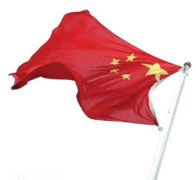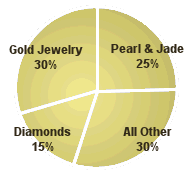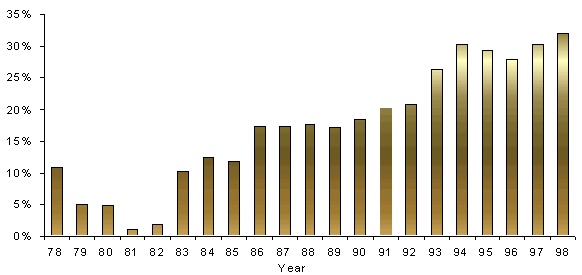China:Rising Like a Rocket
March 31, 07
By Ken Gassman

China is rising like a rocket, bound on a course to join the world’s super powers, putting the country in a position as a global leader that its leaders and people think it rightfully deserves. For three years in a row, the country has posted economic growth of 10 percent or better, according to Chinese government statistics, a level that many foreign analysts think understates the torrid pace of growth.
China has shown incredible resilience in the face of a wave of challenges since the late 1990s. It successfully sailed through the Asian financial crisis, the bursting of the global Internet bubble, a recession in the U.S., and its own internal health crisis with the SARS virus early in the current decade.
Internationally, the country is reaching out to the world – Africa, the U.S., Japan, and others to help fuel its growth.
At home, domestic demand is fueling dramatic growth. A new caste of Chinese millionaires has been spawned, and a new middle class is emerging in large cities across China.
Some economists worry that the country is caught between a mixture of the unstoppable and the unsustainable.
The unstoppable part of the equation is that China’s rapid growth is likely to continue, driven by a high investment rate, swelling exports, and healthy domestic consumption. The unsustainable part of the equation is what every economist knows: no tree grows to the sky.
What most economists miss, though, is the sheer drive and ambition of the Chinese people. For all of the injustice and unfairness meted out by the Chinese system over the past five decades, the huge advances made by so many individuals create the incentive for others to emulate.
Economists point out that the recent dramatic economic growth has created a rich-poor gap, yielding a country that is now more unequal than the U.S. or Russia, an astounding development, given that two decades ago the country was one of the most equal in the world, even if that meant most were poor.
The good news is that all of this economic growth has reduced China’s poverty rate from 16 percent in 2001 to 10 percent in 2004, (as measured by the World Bank’s definition of the percentage of the population living on $1 per day, using global prices). At the same time, the World Bank says that the poorest 10 percent of the Chinese population experienced a reduction of their income of about 2.5 percent, despite rapid economic growth.
Although the country is trying to tackle the disparity between rich and poor, the imbalances and corruption in its political system make for slow progress.
There is no question that there is a huge class of Chinese consumers with dramatic spending power. However, the challenge will be to change their culture.
Longer term, millions of teenagers and early 20-somethings have emerged who could change the landscape of domestic consumption. These are the so-called "Millennials" who are confident of their long term earning power, but live at home, with their parents, and without debt. As a result, they are willing to spend their own hard-earned Yuan. Because the young Chinese consumers are status conscious – with an appetite for the latest mobile phones, clothes, cosmetics, accessories, and luxury goods including jewelry – they are a multi-national marketer’s dream.
This represents an opportunity for jewelers.
China Jewelry & Watch Market Size

Source: Various
In 25 years, China will be the world’s biggest market for diamonds, predicts Stephen Lussier of the Diamond Trading Company (DTC). The DTC expects China’s huge market of 1.3 billion consumers to purchase larger, more expensive diamonds as their personal incomes rise.
China, along with several other Asian markets, may be modest in size now, but they are expected to grow rapidly over the next several decades. With 1.3 billion people or just over 20 percent of the global population, China currently accounts for only about 4 percent of the consumption of diamond jewelry. According to recent forecasts by KPMG, the accounting and consulting firm, China could account for as much as 13 percent of the world’s total diamond and jewelry consumption by 2015, less than ten years from now.
Jewelry Sales Forecast: Up Sharply
According to consensus global forecasts, China’s jewelry sales are set to double in ten years, for a compounded annual growth rate of 7.2 percent. That pace is significantly greater than the current growth of the global diamond jewelry market – about +6 percent annually – and nearly 50 percent faster than that of the U.S. diamond market, currently the world’s largest.
While global consensus forecasts suggest that China’s jewelry sales could reach nearly $22 billion by 2010, China’s internal trade associations see even greater growth. According to the Gems and Jewelry Trade Association of China (GJTAS), sales of diamond, gold, platinum, and other jewelry are expected to top RMB 200 billion ($25.6 billion) by 2010.
In China, as in most developing countries, jewelry demand is driven by several factors, including the following:
w Tradition
w Discretionary income and spending
w Show of wealth
w Status symbols
w Life cycle events (weddings, etc.)
China’s Jewelry Consumption Up
China’s soaring jewelry consumption has made it an important consumer of commodities used in jewelry. In 2004, the country ranked third in the world in terms of annual gold consumption and accounted for more than 50 percent of global platinum sales. Thanks in part to sales of ornamental diamond jewelry, China has become one of the largest diamond markets in Asia, although it still lags far behind Japan.
Diamond jewelry sales in China are up low double-digit levels. Diamond promotions by the DTC, the marketing arm of De Beers, are still in their infancy. Most analysts believe that diamond sales in China represent 4 to 5 percent of global demand.

China’s jewelry-consuming middle class – roughly 100 million consumers – is expected to grow annually by about 10 percent, or an estimated ten million people every year. The southern coastal towns and major cities – particularly Beijing and Shanghai – are home to a growing class of young consumer elite.
Precious Metals Important to Chinese Consumers
Platinum and gold jewelry represent the largest product categories for the Chinese market. The World Gold Council (WGC) has promoted demand for gold jewelry in China with a consumer marketing initiative led by 18 karat yellow gold jewelry in Italian-inspired designs. This campaign was launched after WGC research showed that many of China’s young consumers perceived that gold jewelry was old-fashioned. The three-year campaign is promoting Italian designs, especially to young female consumers.
Over the past decade, China has become the world’s largest market for platinum jewelry. China’s demand for platinum jewelry represents about 52 percent of global consumption. After many years of favoring gold jewelry, it appears that China’s new, young middle-class consumer may be turning to platinum. Platinum promotions focus on the major gift-giving holidays, and are targeted at young female consumers who often buy jewelry for themselves.
In 2005, government statistics suggest that annual sales of platinum amounted to 1.4 to 1.5 million ounces, and the annual demand for gold jewelry reached about 200 tons. Domestic diamond sales reached roughly $1.1 billion, according to official government statistics, though this is well below unofficial estimates of $2 to 3 billion. Government statistics suggest that jewelry consumption has increased at an annual rate of 15 percent. IDEX Online Research’s analysis of the Chinese government’s base data suggests that the annual growth rate of jewelry is more in the range of 10 to 11 percent annually. A substantial cut in the value-added tax (VAT) for jewelry will also help boost consumption. The bottom line is, however, the same. No matter whose figures you use, China’s domestic consumption of jewelry is growing far faster than overall global consumption.
The graph below summarizes jewelry consumption by product category.
China - Jewelry Sales by Product Category

Factors Driving Jewelry Consumption
There are six major factors driving jewelry consumption in China, including:
w Marriages and other life cycle celebrations – Each year, about 20 million Chinese are married. Roughly 5 percent of their total wedding budget is earmarked for jewelry; this means that about $1.5 billion is spent annually on bridal related jewelry.
w Diamond demand – Depending on your source, $1 to $3 billion of diamonds are consumed each year in China. There has been strong demand for higher quality diamond jewelry, including marriage rings with stones of one carat and larger. While roughly 80 percent of women in China’s major city of Shanghai receive a diamond ring, it is not an engagement ring; rather, it is the ring they receive from their spouse on their wedding day – a wedding ring set with smaller diamonds.
In the major cities of Beijing and Shanghai, jewelers report that diamonds in the 0.3 to 0.5 carat range are in very strong demand. Diamond jewelry lets people celebrate their individuality, though this trend remains restrained. As a result of the trend toward individualism, products that are innovative and expensive are increasingly in demand. The DTC has promoted diamond pendants for self-purchase, with increased advertising levels in May and October, when many consumers are on holiday.
w Reduced savings rate – Historically, consumers in China have saved about 30 to 40 percent of their income. In part, this is because they simply do not have anything to spend their money on. There is also some worry about the safety and security of their old age pensions. In part, it is a cultural trait; Chinese consumers have never – in recent times – had significant discretionary income, so they are not inclined to spend money on anything other than their basic needs. However, it is likely that the Chinese will reduce their savings rate; this will add to the discretionary spending power of consumers in China.
w Foreign visitors – More consumers from overseas are visiting China each year, and their demand for unique Chinese jewelry is very strong. Demand for pearls, jade, and silver jewelry is growing rapidly. With Chinese jewelry production techniques improving rapidly, their jewelry is of world-class quality.
w Cultural variations – Cultural variations between younger and older Chinese consumers are emerging as a growth driver of China’s jewelry market. Jewelry retailers say that young Chinese are adopting exaggerated ways to show their love, which older Chinese dismiss as “Westernized.” Culturally, Chinese consumers have traditionally been taught that jewelry should be worn modestly, and that “less is more.” While Valentine’s Day has not been accepted by older Chinese consumers, young Chinese shoppers have welcomed the holiday as an excuse to announce and celebrate their relationships. Watchmakers have joined in to promote watches for men at Valentine’s.
w Global retail – Many global retailers are entering China. About one-third of the world’s 50 largest retailers have already entered China, including five of the top ten. For example, Carrefour, Lotus, Makro, Idea, and Auchan have stores in the country.
Savings Rate As A Percent of GDP - China

Source: World Development Indicators